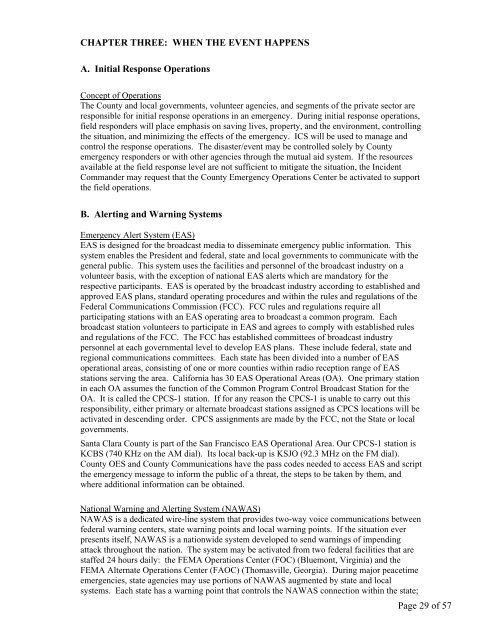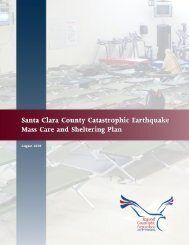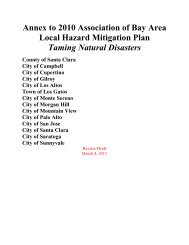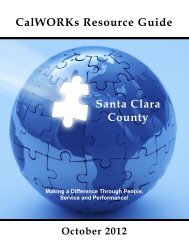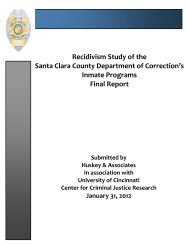Operational Area Emergency Operations Plan - County of Santa Clara
Operational Area Emergency Operations Plan - County of Santa Clara
Operational Area Emergency Operations Plan - County of Santa Clara
You also want an ePaper? Increase the reach of your titles
YUMPU automatically turns print PDFs into web optimized ePapers that Google loves.
CHAPTER THREE: WHEN THE EVENT HAPPENS<br />
A. Initial Response <strong>Operations</strong><br />
Concept <strong>of</strong> <strong>Operations</strong><br />
The <strong>County</strong> and local governments, volunteer agencies, and segments <strong>of</strong> the private sector are<br />
responsible for initial response operations in an emergency. During initial response operations,<br />
field responders will place emphasis on saving lives, property, and the environment, controlling<br />
the situation, and minimizing the effects <strong>of</strong> the emergency. ICS will be used to manage and<br />
control the response operations. The disaster/event may be controlled solely by <strong>County</strong><br />
emergency responders or with other agencies through the mutual aid system. If the resources<br />
available at the field response level are not sufficient to mitigate the situation, the Incident<br />
Commander may request that the <strong>County</strong> <strong>Emergency</strong> <strong>Operations</strong> Center be activated to support<br />
the field operations.<br />
B. Alerting and Warning Systems<br />
<strong>Emergency</strong> Alert System (EAS)<br />
EAS is designed for the broadcast media to disseminate emergency public information. This<br />
system enables the President and federal, state and local governments to communicate with the<br />
general public. This system uses the facilities and personnel <strong>of</strong> the broadcast industry on a<br />
volunteer basis, with the exception <strong>of</strong> national EAS alerts which are mandatory for the<br />
respective participants. EAS is operated by the broadcast industry according to established and<br />
approved EAS plans, standard operating procedures and within the rules and regulations <strong>of</strong> the<br />
Federal Communications Commission (FCC). FCC rules and regulations require all<br />
participating stations with an EAS operating area to broadcast a common program. Each<br />
broadcast station volunteers to participate in EAS and agrees to comply with established rules<br />
and regulations <strong>of</strong> the FCC. The FCC has established committees <strong>of</strong> broadcast industry<br />
personnel at each governmental level to develop EAS plans. These include federal, state and<br />
regional communications committees. Each state has been divided into a number <strong>of</strong> EAS<br />
operational areas, consisting <strong>of</strong> one or more counties within radio reception range <strong>of</strong> EAS<br />
stations serving the area. California has 30 EAS <strong>Operational</strong> <strong>Area</strong>s (OA). One primary station<br />
in each OA assumes the function <strong>of</strong> the Common Program Control Broadcast Station for the<br />
OA. It is called the CPCS-1 station. If for any reason the CPCS-1 is unable to carry out this<br />
responsibility, either primary or alternate broadcast stations assigned as CPCS locations will be<br />
activated in descending order. CPCS assignments are made by the FCC, not the State or local<br />
governments.<br />
<strong>Santa</strong> <strong>Clara</strong> <strong>County</strong> is part <strong>of</strong> the San Francisco EAS <strong>Operational</strong> <strong>Area</strong>. Our CPCS-1 station is<br />
KCBS (740 KHz on the AM dial). Its local back-up is KSJO (92.3 MHz on the FM dial).<br />
<strong>County</strong> OES and <strong>County</strong> Communications have the pass codes needed to access EAS and script<br />
the emergency message to inform the public <strong>of</strong> a threat, the steps to be taken by them, and<br />
where additional information can be obtained.<br />
National Warning and Alerting System (NAWAS)<br />
NAWAS is a dedicated wire-line system that provides two-way voice communications between<br />
federal warning centers, state warning points and local warning points. If the situation ever<br />
presents itself, NAWAS is a nationwide system developed to send warnings <strong>of</strong> impending<br />
attack throughout the nation. The system may be activated from two federal facilities that are<br />
staffed 24 hours daily: the FEMA <strong>Operations</strong> Center (FOC) (Bluemont, Virginia) and the<br />
FEMA Alternate <strong>Operations</strong> Center (FAOC) (Thomasville, Georgia). During major peacetime<br />
emergencies, state agencies may use portions <strong>of</strong> NAWAS augmented by state and local<br />
systems. Each state has a warning point that controls the NAWAS connection within the state;<br />
Page 29 <strong>of</strong> 57


